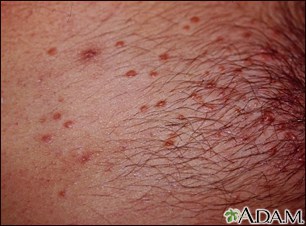Welcome to Your Parenting Guide on Molluscum Contagiosum
Hello, super moms and dads! Are you worried about little bumps on your child’s skin? Have you heard the term molluscum contagiosum and found yourself frantically searching for answers? Breathe easy, because you’ve come to the right place! Today, we’re delving into the nitty-gritty of molluscum contagiosum to empower you with knowledge and calm those concerns.
What Exactly Is Molluscum Contagiosum?
Molluscum contagiosum is a common skin condition that’s caused by a pesky virus from the poxvirus family. It might sound like something out of a pirate’s tale, but it’s actually quite a regular guest in children’s skin stories. This condition is characterized by small, pearly, flesh-colored bumps that often have a little dimple in the center. Cute and often harmless, they’re the skin equivalent of finding a stray bead from a necklace.
These bumps can show up anywhere on the body, but they seem to have a special liking for areas like the torso, arms, and legs. The face, palms, and soles are big no-go zones for these molluscum mischief-makers.
Is Molluscum Contagiosum an STD?
Let’s address the elephant in the room, shall we? Is molluscum contagiosum an STD? Okay, here’s the scoop: while molluscum contagiosum can be transmitted through sexual contact in adults, in kids, it’s often just a simple skin-to-skin tale. Kids are adventurous, and their play often leads to close contact that can spread these little bumps. So, while it can be classified as an STD in certain contexts, in the playground world of children, it’s really not the “S” word in STD that we’re dealing with.
How Does Molluscum Contagiosum Spread?
Catchy as a pop song, molluscum contagiosum travels from one host to another through direct contact with the lesions or through contact with contaminated objects – think towels, clothes, toys, or even wrestling mats. Yes, it’s an opportunist but in a way that’s no different from colds or playground scrapes – it’s a part of growing up.
Managing Molluscum Contagiosum
Management starts with understanding that while molluscum contagiosum is contagious, it’s not a scarlet letter. It’s a temporary skin guest that usually resolves on its own. If you have little worriers at home, assure them that these bumps are the skin’s way of telling cool stories about playtime and exploration.
However, since no one likes uninvited guests, there are ways to manage and even evict them. Some treatments include topical creams, cryotherapy, and curettage. But hold those horses, treatments are typically for adults or cases that really need intervention. For most kiddos, practicing good hygiene and waiting it out with patience (and maybe a dash of distraction) can work wonders.
Prevention Is Better Than Cure!
Avoid the spread of molluscum contagiosum in your household with simple preventive measures. Remind your kids about the importance of not sharing personal items, like towels and clothing, and encourage them to practice proper hand hygiene. Like teaching them to tie their shoes, it’s all about those life skills.
Now that we’ve eased some of your initial concerns, stay tuned as we dive deeper into treatment options, extra prevention tips, and strategies to keep your kids comfortable and smiling, despite these little skin stowaways. After all, informed parenting is happy parenting!

Your Comprehensive Guide to Molluscum Contagiosum in Children
Hey there, amazing parents! Noticed some unusual, tiny bumps on your child’s skin recently? It’s quite possible you’re looking at molluscum contagiosum, and guess what? It’s more common than you think. This thorough guide will walk you through the ins and outs of this condition, shedding light on the essential facts and debunking myths along the way.
Demystifying Molluscum Contagiosum
Molluscum contagiosum is an infectious skin condition, courtesy of a poxvirus, leading to round, painless bumps on the skin. These bumps might seem strange, but they’re just part of how our bodies interact with the environment. They’re not a cause for alarm, and they’re definitely not discriminatory—they can appear on any kid!
Often showing up on arms, legs, and the torso, these bumps enjoy a benign existence away from sensitive areas like the face and feet. The unique central dimple is their signature—the molluscum contagiosum calling card!
Addressing the Misconception: Is Molluscum Contagiosum an STD?
One of the biggest misunderstandings about molluscum contagiosum is whether it’s an STD. Here’s the lowdown: For children, molluscum contagiosum is NOT an STD. It does spread through skin contact, which can include sexual contact for adults, but when it comes to kids, it’s usually a product of their explorative nature and their social, tactile learning.
The Five Things Every Parent Should Know About Molluscum Contagiosum
- Understanding Transmission: The virus spreads through direct contact with infected skin or items. This means that your child can catch it from sharing towels, clothes, or engaging in activities like wrestling, where skin contacts are common.
- It’s Mostly Harmless: These bumps might not win a beauty contest, but they’re usually harmless and pain-free. In most cases, they’ll clear on their own without leaving a mark.
- When to Seek Treatment: While the body often takes care of molluscum contagiosum by itself, visit a healthcare professional if the lesions are in sensitive areas, last longer than expected, or your child has a compromised immune system.
- Patience is Key: The bumps can stick around for a few months (sometimes even years), but patience is essential. Avoid picking or scratching them, as this can lead to scars or spread the virus to other skin parts.
- Preventive Tactics: Encourage personal hygiene, such as not sharing towels or clothing, and handwashing routinely to prevent the spread within your home or to other children.
Strategic Management at Home
Accepting molluscum contagiosum as part of your child’s growth can be liberating. Teach them about personal space and hygiene in a fun way that doesn’t add pressure or stress. If treatment becomes necessary, options range from topicals to minor procedures—but these are rarely needed for the little ones.
Creating a Safe and Understanding Environment
It’s vital to cultivate a nurturing environment where skin conditions aren’t a big deal. Normalize skin differences and teach kids it’s part of what makes us all unique. With a loving, educated approach, you can ensure that your child feels confident and accepted, bumps or no bumps.
Keeping Up the Spirits!
Equip yourself with the right knowledge and preventive strategies to tackle molluscum contagiosum with confidence. Let’s keep the joy in the childhood by focusing on health education and empathy, enabling our children to thrive in all aspects—beautiful skin bumps aside. Remember, through understanding and love, we can make every challenge a lesson in compassion and resilience.
See more great Things to Do with Kids in New Zealand here. For more information see here
Disclaimer
The articles available via our website provide general information only and we strongly urge readers to exercise caution and conduct their own thorough research and fact-checking. The information presented should not be taken as absolute truth, and, to the maximum extent permitted by law, we will not be held liable for any inaccuracies or errors in the content. It is essential for individuals to independently verify and validate the information before making any decisions or taking any actions based on the articles.




